Abstract
The effects of hypercapnia and hypocapnia on respiratory resistance were studied in 15 healthy subjects and 30 asthmatic subjects. Respiratory resistance (impedance) was measured with the pseudo-random noise forced oscillation technique while the subjects rebreathed from a wet spirometer in a closed respiratory circuit in which end tidal carbon dioxide tension (PCO2) could be controlled. Hypercapnia was induced by partially short circuiting the carbon dioxide absorber, and hypocapnia by voluntary hyperventilation. The circulating air was saturated with water vapour and kept at body temperature and ambient pressure. A rise of end tidal PCO2 of 1 kPa caused a significant fall in respiratory resistance in both normal and asthmatic subjects (15% and 9% respectively). A fall of PCO2 of 1 kPa did not cause any significant change in impedance in the control group. In the asthmatic patients resistance increased by 13%, reactance fell by 45%, and the frequency dependence of resistance rose 240%. These findings confirm that hypocapnia may contribute to airway obstruction in asthmatic patients, even when water and heat loss are prevented.
Full text
PDF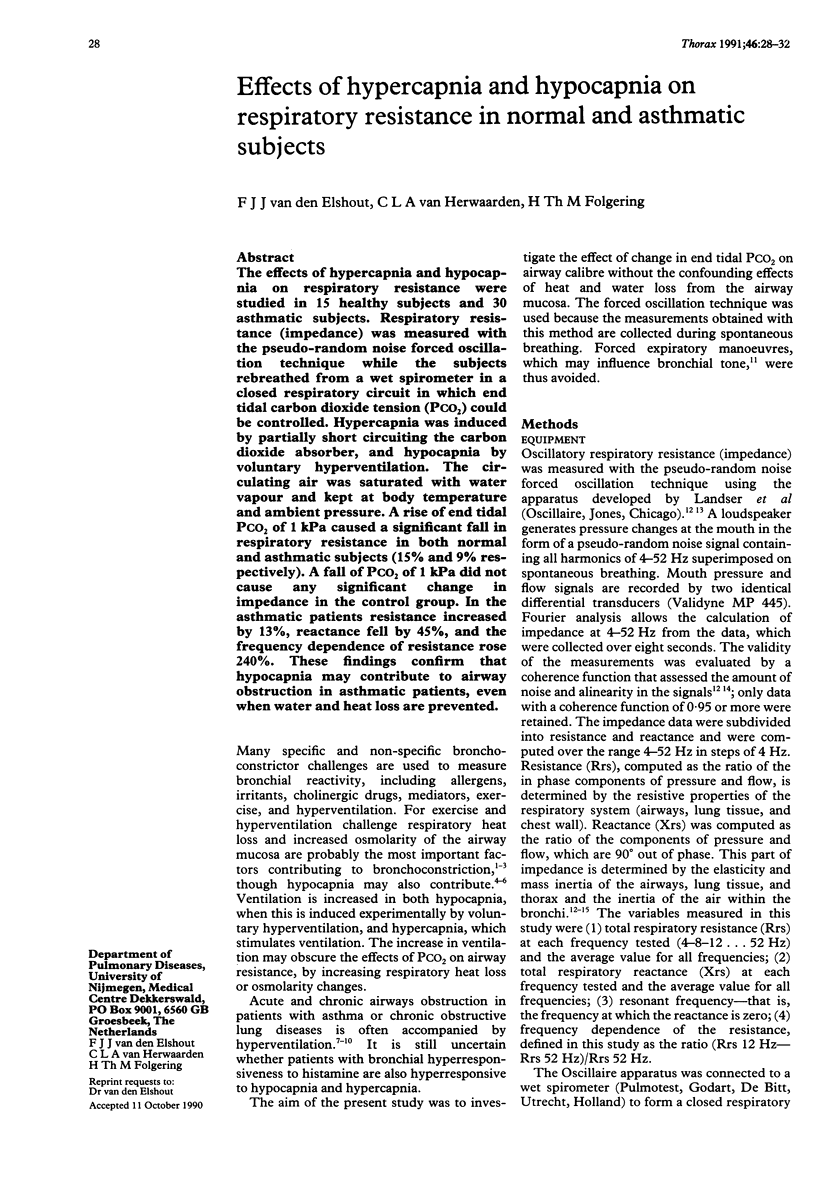
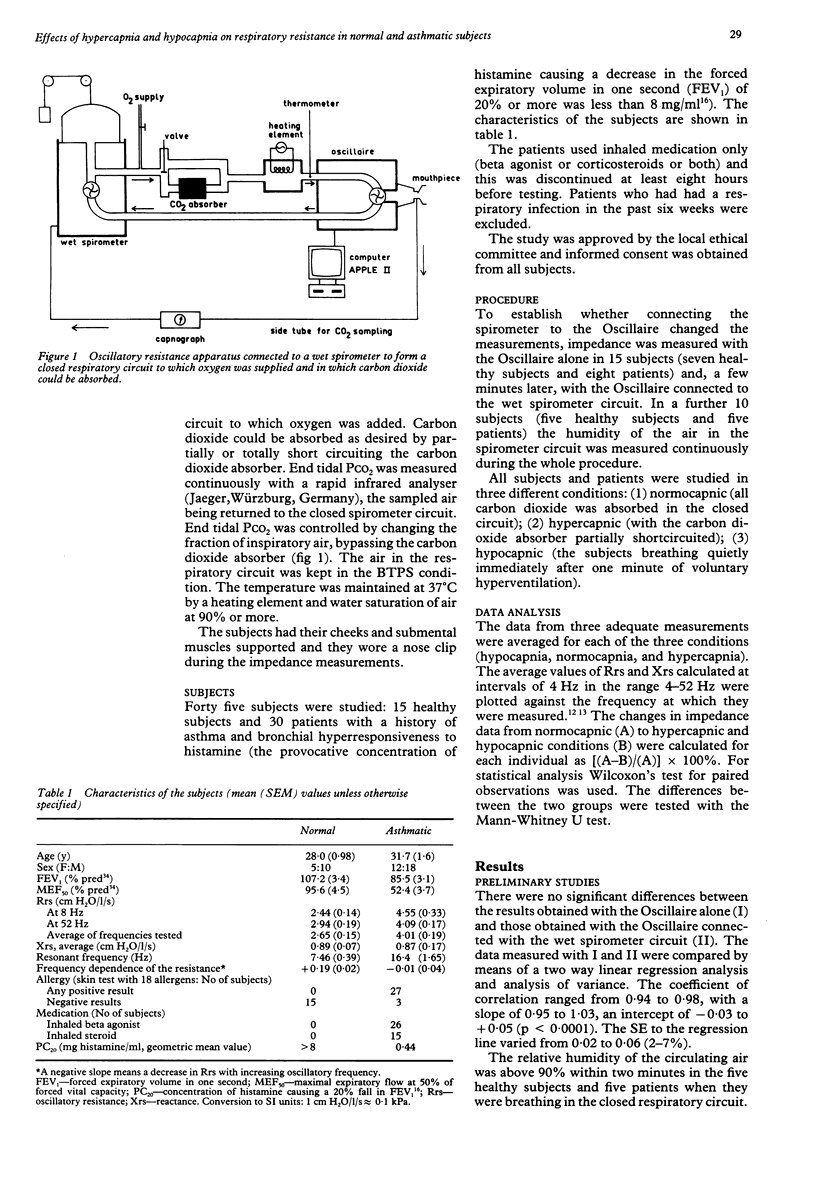
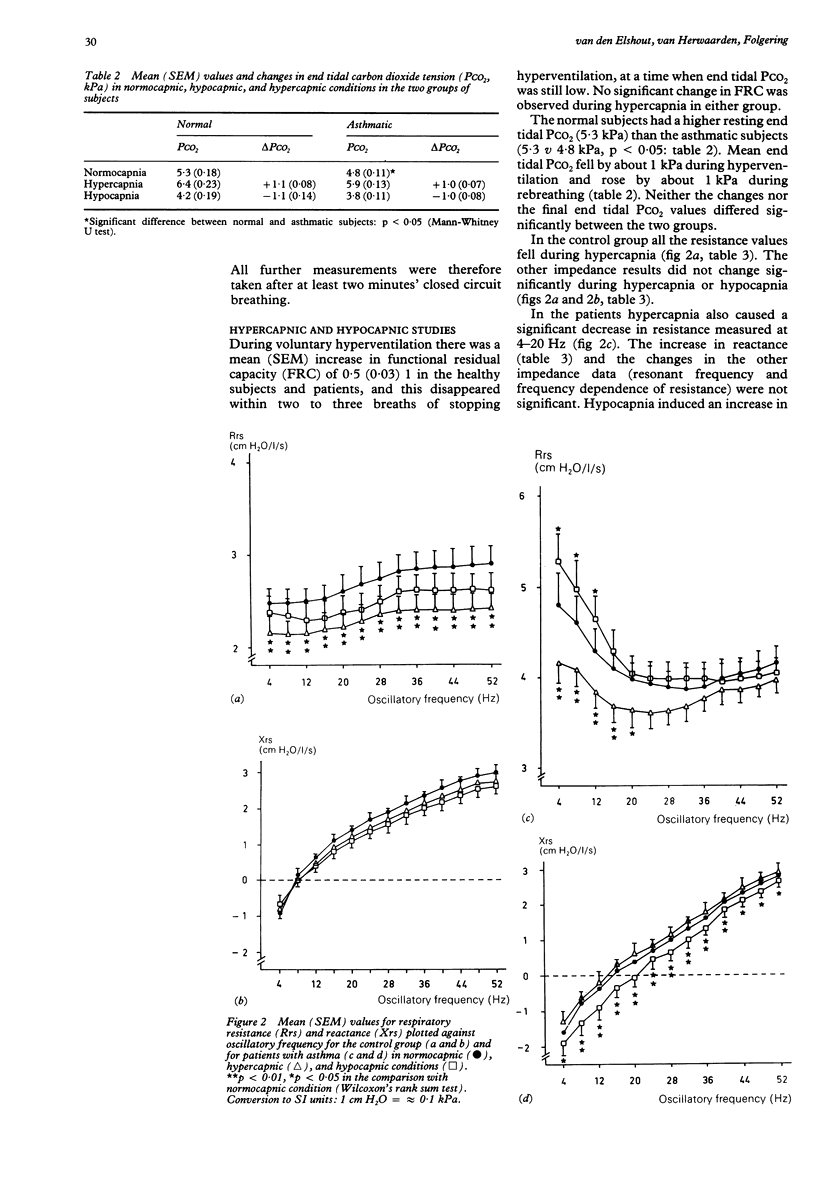
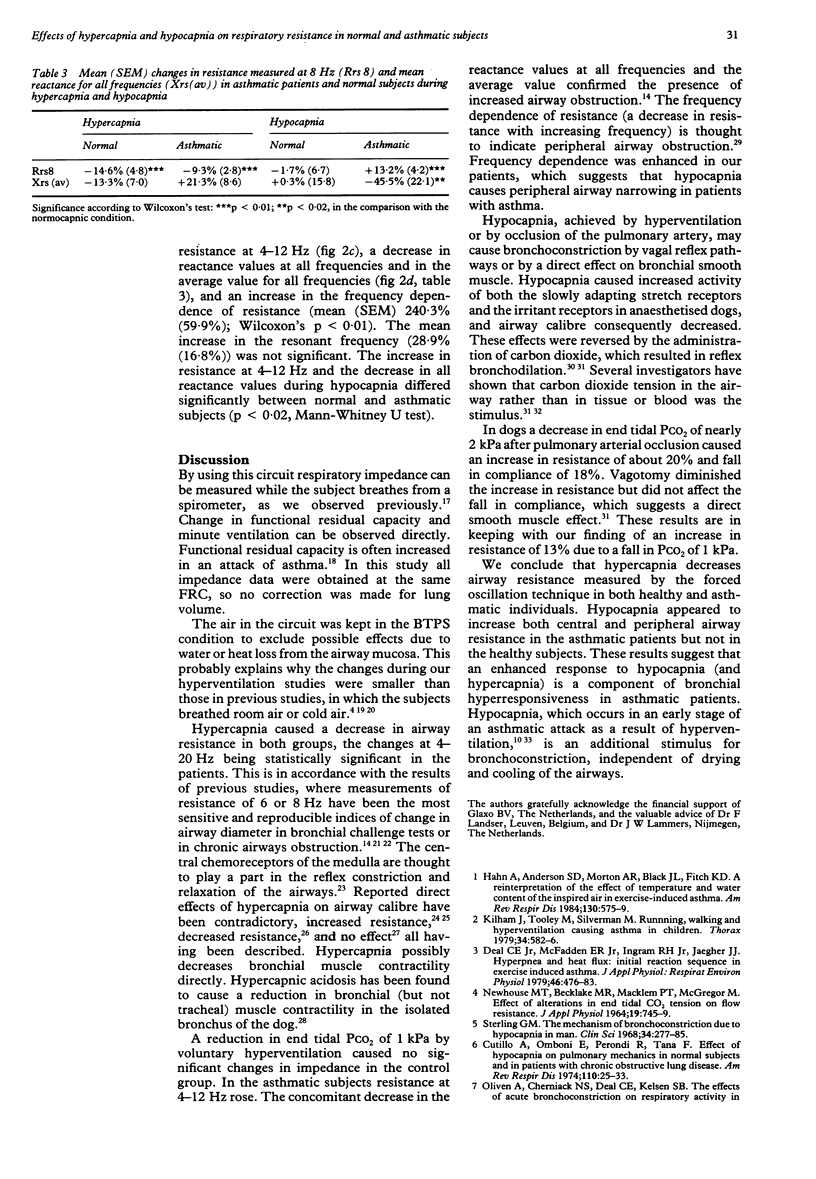
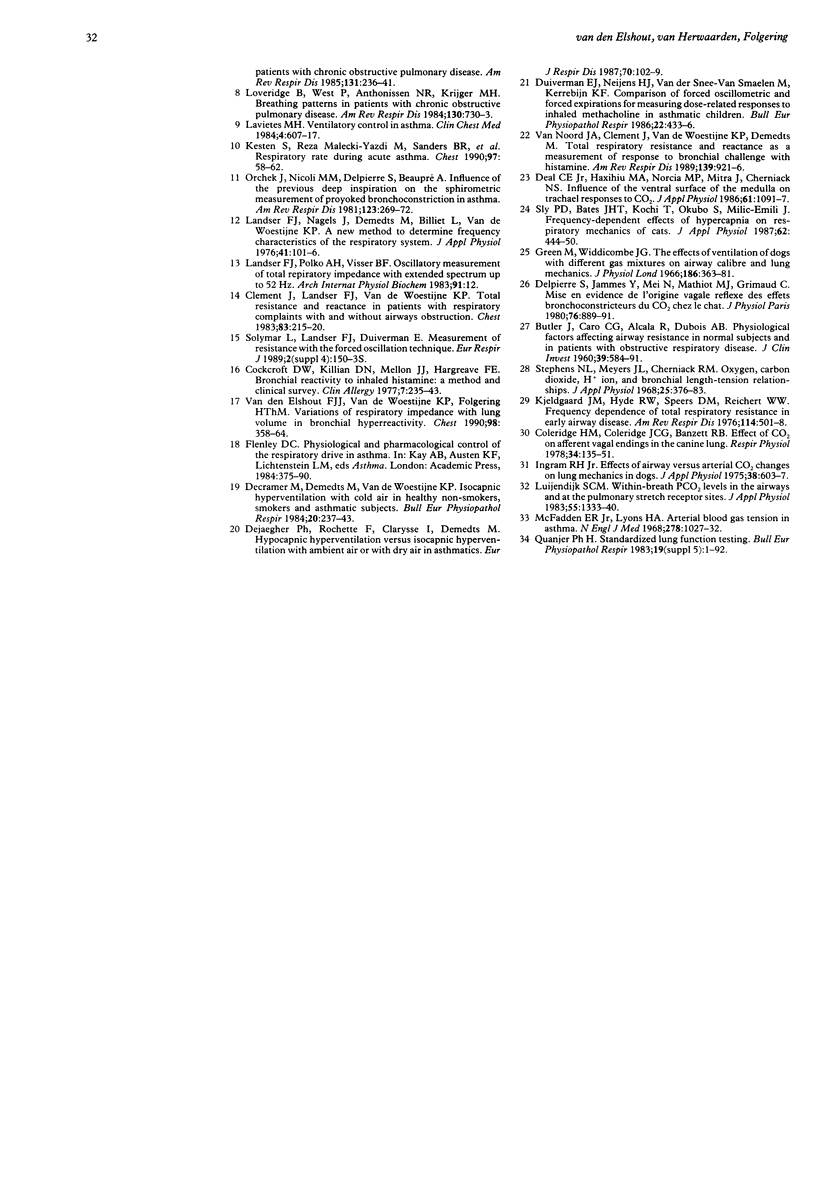
Selected References
These references are in PubMed. This may not be the complete list of references from this article.
- BUTLER J., CARO C. G., ALCALA R., DUBOIS A. B. Physiological factors affecting airway resistance in normal subjects and in patients with obstructive respiratory disease. J Clin Invest. 1960 Apr;39:584–591. doi: 10.1172/JCI104071. [DOI] [PMC free article] [PubMed] [Google Scholar]
- Cockcroft D. W., Killian D. N., Mellon J. J., Hargreave F. E. Bronchial reactivity to inhaled histamine: a method and clinical survey. Clin Allergy. 1977 May;7(3):235–243. doi: 10.1111/j.1365-2222.1977.tb01448.x. [DOI] [PubMed] [Google Scholar]
- Coleridge H. M., Coleridge J. C., Banzett R. B. II. Effect of CO2 on afferent vagal endings in the canine lung. Respir Physiol. 1978 Jul;34(1):135–151. doi: 10.1016/0034-5687(78)90053-1. [DOI] [PubMed] [Google Scholar]
- Cutillo A., Omboni E., Perondi R., Tana F. Effect of hypocapnia on pulmonary mechanics in normal subjects and in patients with chronic obstructive lung disease. Am Rev Respir Dis. 1974 Jul;110(1):25–33. doi: 10.1164/arrd.1974.110.1.25. [DOI] [PubMed] [Google Scholar]
- Deal E. C., Jr, Haxhiu M. A., Norcia M. P., Mitra J., Cherniack N. S. Influence of the ventral surface of the medulla on tracheal responses to CO2. J Appl Physiol (1985) 1986 Sep;61(3):1091–1097. doi: 10.1152/jappl.1986.61.3.1091. [DOI] [PubMed] [Google Scholar]
- Deal E. C., Jr, McFadden E. R., Jr, Ingram R. H., Jr, Jaeger J. J. Hyperpnea and heat flux: initial reaction sequence in exercise-induced asthma. J Appl Physiol Respir Environ Exerc Physiol. 1979 Mar;46(3):476–483. doi: 10.1152/jappl.1979.46.3.476. [DOI] [PubMed] [Google Scholar]
- Decramer M., Demedts M., van de Woestijne K. P. Isocapnic hyperventilation with cold air in healthy non-smokers, smokers and asthmatic subjects. Bull Eur Physiopathol Respir. 1984 May-Jun;20(3):237–243. [PubMed] [Google Scholar]
- Dejaegher P., Rochette F., Clarysse I., Demedts M. Hypocapnic hyperventilation versus isocapnic hyperventilation with ambient air or with dry air in asthmatics. Eur J Respir Dis. 1987 Feb;70(2):102–109. [PubMed] [Google Scholar]
- Delpierre S., Jammes Y., Mei N., Mathiot M. J., Grimaud C. Mise en évidence de l'origine vagale réflexe des effets bronchoconstricteurs du CO2 chez le chat. J Physiol (Paris) 1980;76(8):889–891. [PubMed] [Google Scholar]
- Duiverman E. J., Neijens H. J., Van der Snee-van Smaalen M., Kerrebijn K. F. Comparison of forced oscillometry and forced expirations for measuring dose-related responses to inhaled methacholine in asthmatic children. Bull Eur Physiopathol Respir. 1986 Sep-Oct;22(5):433–436. [PubMed] [Google Scholar]
- Green M., Widdicombe J. G. The effects of ventilation of dogs with different gas mixtures on airway calibre and lung mechanics. J Physiol. 1966 Oct;186(2):363–381. doi: 10.1113/jphysiol.1966.sp008040. [DOI] [PMC free article] [PubMed] [Google Scholar]
- Hahn A., Anderson S. D., Morton A. R., Black J. L., Fitch K. D. A reinterpretation of the effect of temperature and water content of the inspired air in exercise-induced asthma. Am Rev Respir Dis. 1984 Oct;130(4):575–579. doi: 10.1164/arrd.1984.130.4.575. [DOI] [PubMed] [Google Scholar]
- Ingram R. H., Jr Effects of airway versus arterial CO2 changes on lung mechanics in dogs. J Appl Physiol. 1975 Apr;38(4):603–607. doi: 10.1152/jappl.1975.38.4.603. [DOI] [PubMed] [Google Scholar]
- Kesten S., Maleki-Yazdi R., Sanders B. R., Wells J. A., McKillop S. L., Chapman K. R., Rebuck A. S. Respiratory rate during acute asthma. Chest. 1990 Jan;97(1):58–62. doi: 10.1378/chest.97.1.58. [DOI] [PubMed] [Google Scholar]
- Kilham H., Tooley M., Silverman M. Running, walking, and hyperventilation causing asthma in children. Thorax. 1979 Oct;34(5):582–586. doi: 10.1136/thx.34.5.582. [DOI] [PMC free article] [PubMed] [Google Scholar]
- Kjeldgaard J. M., Hyde R. W., Speers D. M., Reichert W. W. Frequency dependence of total respiratory resistance in early airway disease. Am Rev Respir Dis. 1976 Sep;114(3):501–508. doi: 10.1164/arrd.1976.114.3.501. [DOI] [PubMed] [Google Scholar]
- Lavietes M. H. Ventilatory control in asthma. Clin Chest Med. 1984 Dec;5(4):607–617. [PubMed] [Google Scholar]
- Loveridge B., West P., Anthonisen N. R., Kryger M. H. Breathing patterns in patients with chronic obstructive pulmonary disease. Am Rev Respir Dis. 1984 Nov;130(5):730–733. doi: 10.1164/arrd.1984.130.5.730. [DOI] [PubMed] [Google Scholar]
- Luijendijk S. C. Within-breath PCO2 levels in the airways and at the pulmonary stretch receptor sites. J Appl Physiol Respir Environ Exerc Physiol. 1983 Oct;55(4):1333–1340. doi: 10.1152/jappl.1983.55.4.1333. [DOI] [PubMed] [Google Scholar]
- Lándsér F. J., Nagles J., Demedts M., Billiet L., van de Woestijne K. P. A new method to determine frequency characteristics of the respiratory system. J Appl Physiol. 1976 Jul;41(1):101–106. doi: 10.1152/jappl.1976.41.1.101. [DOI] [PubMed] [Google Scholar]
- McFadden E. R., Jr, Lyons H. A. Arterial-blood gas tension in asthma. N Engl J Med. 1968 May 9;278(19):1027–1032. doi: 10.1056/NEJM196805092781901. [DOI] [PubMed] [Google Scholar]
- NEWHOUSE M. T., BECKLAKE M. R., MACKLEM P. T., MCGREGOR M. EFFECT OF ALTERATIONS IN END-TIDAL CO2 TENSION ON FLOW RESISTANCE. J Appl Physiol. 1964 Jul;19:745–749. doi: 10.1152/jappl.1964.19.4.745. [DOI] [PubMed] [Google Scholar]
- Oliven A., Cherniack N. S., Deal E. C., Kelsen S. G. The effects of acute bronchoconstriction on respiratory activity in patients with chronic obstructive pulmonary disease. Am Rev Respir Dis. 1985 Feb;131(2):236–241. doi: 10.1164/arrd.1985.131.2.236. [DOI] [PubMed] [Google Scholar]
- Orehek J., Nicoli M. M., Delpierre S., Beaupre A. Influence of the previous deep inspiration on the spirometric measurement of provoked bronchoconstriction in asthma. Am Rev Respir Dis. 1981 Mar;123(3):269–272. doi: 10.1164/arrd.1981.123.3.269. [DOI] [PubMed] [Google Scholar]
- Sly P. D., Bates J. H., Kochi T., Okubo S., Milic-Emili J. Frequency-dependent effects of hypercapnia on respiratory mechanics of cats. J Appl Physiol (1985) 1987 Feb;62(2):444–450. doi: 10.1152/jappl.1987.62.2.444. [DOI] [PubMed] [Google Scholar]
- Standardized lung function testing. Report working party. Bull Eur Physiopathol Respir. 1983 Jul;19 (Suppl 5):1–95. [PubMed] [Google Scholar]
- Sterling G. M. The mechanism of bronchoconstriction due to hypocapnia in man. Clin Sci. 1968 Apr;34(2):277–285. [PubMed] [Google Scholar]
- van Noord J. A., Clement J., van de Woestijne K. P., Demedts M. Total respiratory resistance and reactance as a measurement of response to bronchial challenge with histamine. Am Rev Respir Dis. 1989 Apr;139(4):921–926. doi: 10.1164/ajrccm/139.4.921. [DOI] [PubMed] [Google Scholar]
- van den Elshout F. J., van de Woestijne K. P., Folgering H. T. Variations of respiratory impedance with lung volume in bronchial hyperreactivity. Chest. 1990 Aug;98(2):358–364. doi: 10.1378/chest.98.2.358. [DOI] [PubMed] [Google Scholar]


